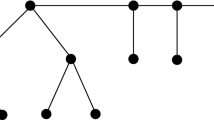Abstract
Given an edge weighted tree T and two non-negative real numbers d min and d max , a pairwise compatibility graph (PCG) of T is a graph G=(V,E), where each vertex u∈V corresponds to a leaf u of T and an edge (u,v)∈E if and only if d min ≤distance(u,v)≤d max in T. In this paper we give some properties of these graphs. We establish a relationship between pairwise compatibility graphs and chordal graphs. We show that all chordless cycles and single chord cycles are pairwise compatibility graphs. We also provide a linear-time algorithm for constructing trees that can generate graphs having cycles as their maximal biconnected subgraphs as PCGs. The techniques that we used to identify various types of pairwise compatibility graphs are quite generic and may be useful to discover other properties of these graphs.
Similar content being viewed by others
References
Jones, N.C., Pevzner, P.A.: An Introduction to Bioinformatics Algorithms. MIT Press, Cambridge (2004)
Lesk, A.M.: Introduction to Bioinformatics. Oxford University Press, Oxford (2002)
Kearney, P.E., Munro, J.I., Phillips, D.: Efficient generation of uniform samples from phylogenetic trees. In: Benson, G., Page, R.D.M. (eds.) WABI. Lecture Notes in Computer Science, vol. 2812, pp. 177–189. Springer, Berlin (2003)
Cormen, T.H., Leiserson, C.E., Rivest, R.L., Stein, C.: Introduction to Algorithms. MIT Press, Cambridge (2001)
Pardalos, P.M., Xue, J.: The maximum clique problem. J. Glob. Optim. 4(3), 301–328 (1994). http://dx.doi.org/10.1007/BF01098364
Bomze, I.M., Budinich, M., Pardalos, P.M., Pelillo, M.: Handbook of Combinatorial Optimization, vol. 4. Kluwer Academic, Dordrecht (1999)
Lin, G.H., Jiang, T., Kearney, P.E.: Phylogenetic k-root and steiner k-root. In: ISAAC ’00: Proceedings of the 11th International Conference on Algorithms and Computation. Lecture Notes in Computer Science, vol. 1969, pp. 539–551. Springer, Berlin (2000)
Kearney, P.E., Corneil, D.G.: Tree powers. J. Algorithms 29(1), 111–131 (1998). http://dx.doi.org/10.1006/jagm.1998.9999
Phillips, D.: Uniform sampling from phylogenetics trees. Master’s Thesis, University of Waterloo (2002)
Yanhaona, M.N., Hossain, K.S.M.T., Rahman, M.S.: Pairwise compatibility graphs. In: Nakano, S.I., Rahman, M.S. (eds.) WALCOM. Lecture Notes in Computer Science, vol. 4921, pp. 222–233. Springer, Berlin (2008)
West, D.B.: Introduction to Graph Theory. Prentice Hall, New York (2003)
Author information
Authors and Affiliations
Corresponding author
Additional information
An erratum to this article can be found at http://dx.doi.org/10.1007/s12190-008-0215-4
Rights and permissions
About this article
Cite this article
Yanhaona, M.N., Hossain, K.S.M.T. & Rahman, M.S. Pairwise compatibility graphs. J. Appl. Math. Comput. 30, 479–503 (2009). https://doi.org/10.1007/s12190-008-0204-7
Received:
Revised:
Published:
Issue Date:
DOI: https://doi.org/10.1007/s12190-008-0204-7




